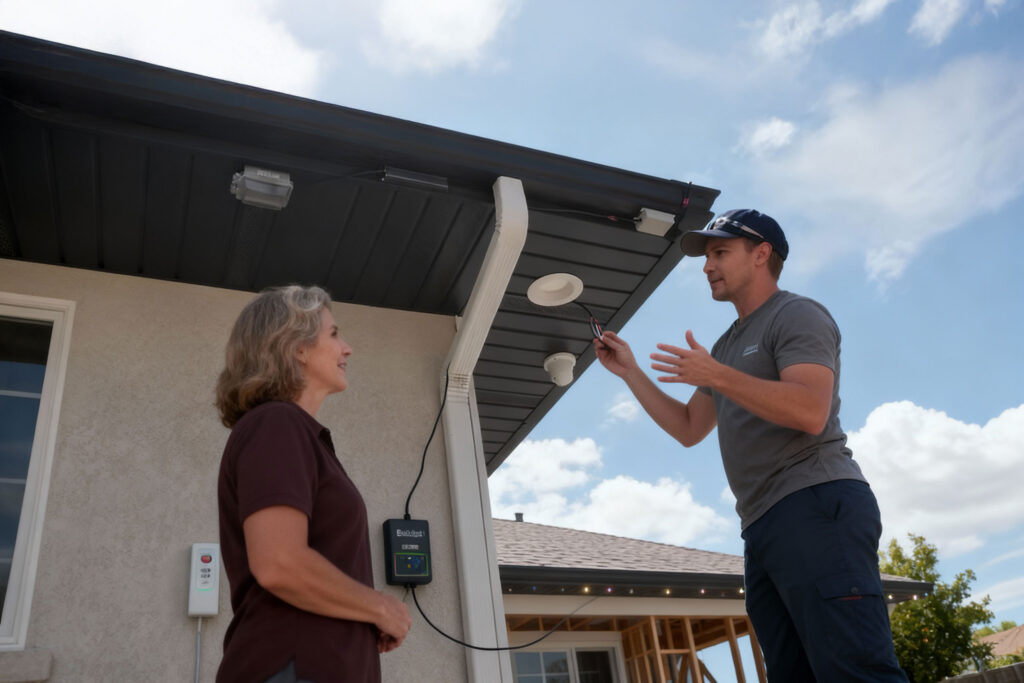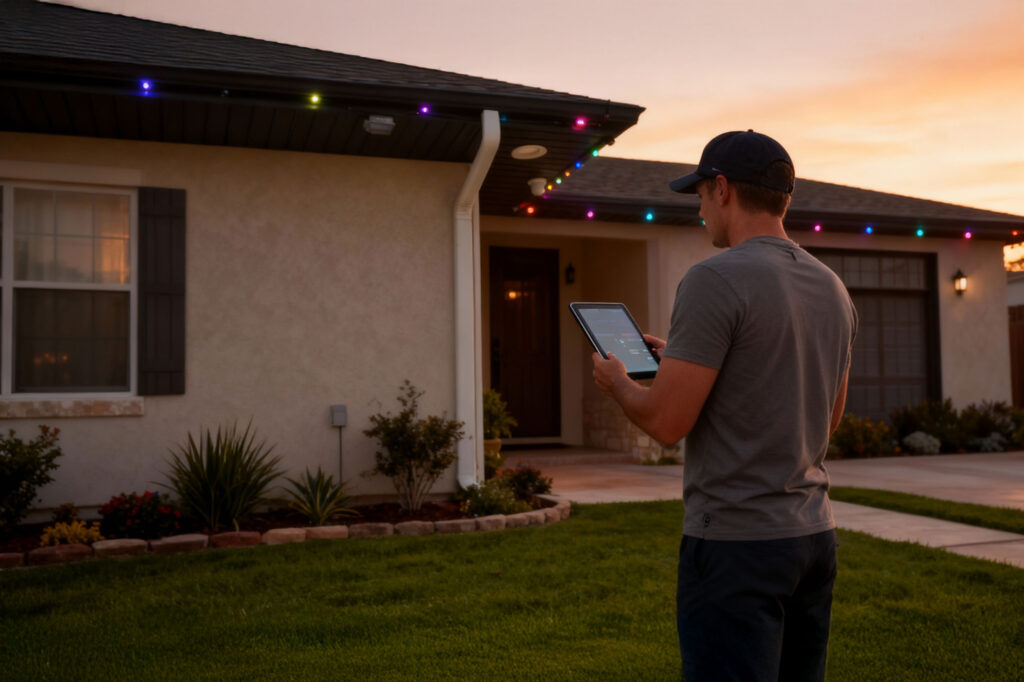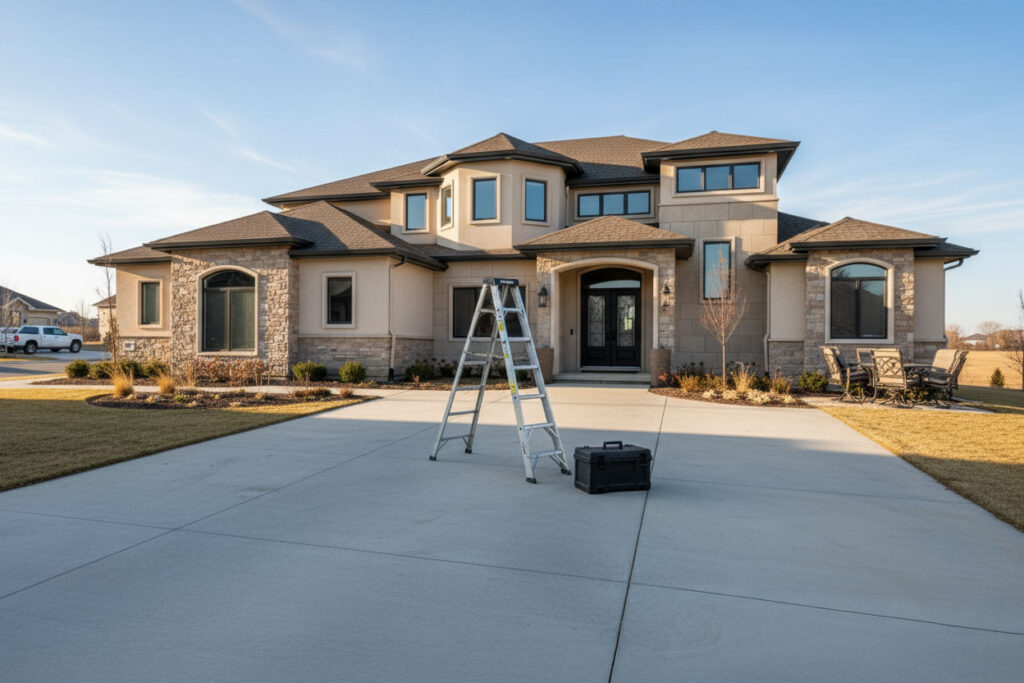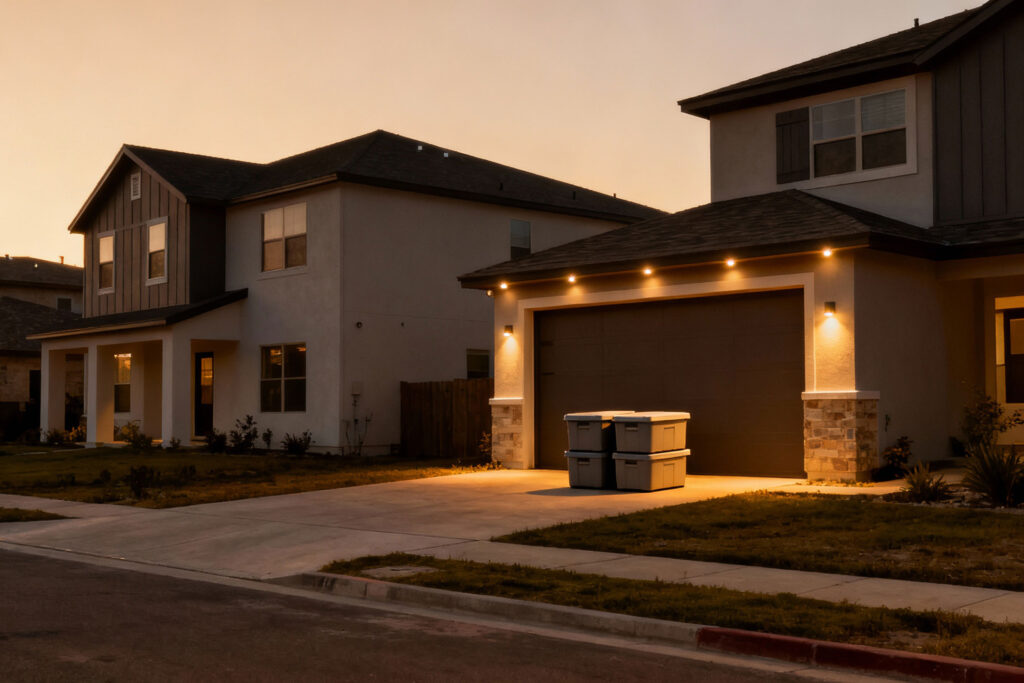Like Prometheus bringing light to humanity, we’ve got bright illumination in our homes—but occasionally these modern marvels refuse to cooperate. We’ll address the frustrating disconnect when your app says “connected,” but your room remains stubbornly dark. From Wi-Fi interference to outdated firmware, the culprits are numerous but often simple to fix. Our troubleshooting guide breaks down each potential issue and provides step-by-step solutions to restore harmony to your innovative lighting ecosystem. If your setup includes permanent smart roofline lighting, the same principles apply.
Key Takeaways
- Verify Wi-Fi connectivity and ensure your smart lights are within range of the controller.
- Update firmware and apps regularly, as outdated software is responsible for 80% of common malfunctions (Source).
- Power-cycle devices by turning them off/on, or perform brand-specific factory resets following manufacturer instructions (Source).
- Reduce signal interference by repositioning devices away from concrete walls, metal fixtures, or competing electronic devices (Source).
- Verify your devices use compatible communication protocols, and consider using a universal smart home controller.
Standard Connection Issues: Wi-Fi and Bluetooth Problems
Please explain why smart lights might suddenly stop responding to your commands. The culprit is often a connectivity failure. When troubleshooting smart lighting, verify that your Wi-Fi network is operational and within range of your controller. Many systems require stable 2.4 GHz connections rather than 5 GHz (Govee: Wi-Fi & Bluetooth Troubleshooting). For holiday displays that use removable strings, double-check the controller location you used during seasonal roofline installation—moving it even a few feet can restore the signal.
For Bluetooth-connected systems like Everlights, sync-fix procedures typically involve closing and reopening the app, ensuring Bluetooth is enabled on your mobile device, and standing within 30 feet of the controller. If problems persist, a Govee controller reset might be necessary—unplug the power source, wait 10 seconds, then reconnect (Govee Troubleshooting Guide: Bluetooth and Reset). If you’re unsure which controller you have, our overview of permanent lighting systems explains standard hardware and app pairings.
Remember that walls, appliances, and interference from other electronic devices can disrupt signals. Repositioning your router or controller often resolves these invisible communication barriers. For systems installed by professionals, local, licensed, insured installers can verify where the signals are installed and ensure everything works well with options acceptable to your HOA; we outline best practices on our smart rooflines page.
Firmware and App Updates: Keeping Your System Current
Outdated software often lies at the heart of smart lighting failures, even when connectivity appears normal. We recommend checking both your controller’s firmware and your smartphone app monthly to prevent sync issues. Most manufacturers push critical updates quarterly that address security vulnerabilities and compatibility problems.
When troubleshooting holiday lighting in San Antonio homes, we’ve found that enabling automatic updates prevents 80% of common malfunctions. Check the update section of your app for any pending installations if, even after a Wi-Fi reset, your lights are still not responding. If you’re weighing whether an upgrade makes sense, our permanent lighting pricing guide breaks down controller tiers and features.
To fix persistent issues with smart LED repair, try reinstalling your control application after uninstalling it. This refreshes permission settings and clears corrupt cache files that may block proper communication between devices. Remember that newer bulbs sometimes require updated software to access their complete feature set. We also compare app ecosystems and scheduling options within smart roofline installations.
Power Supply and Wiring Concerns
Electrical fluctuations, though often overlooked, can severely disrupt smart lighting performance even when network connectivity appears strong. We’ve found that unstable power delivery usually causes lights to disconnect from their control systems, leading to synchronization failures.
Check your circuit’s voltage stability using a multimeter, and consider installing surge protectors for your smart hubs and controllers. When inspecting your setup, look for loose connections at junction points and verify that transformers aren’t overloaded with too many devices.
For outdoor installations, confirm that humidity hasn’t compromised weatherproof seals on connection points. If problems persist after power stabilization, we recommend tracing the signal path to identify potential interference sources or wiring faults. Most systems require clean, consistent power to maintain reliable communication between components. If you installed your system during a temporary display, our notes on seasonal roofline setups address common waterproofing and teardown mistakes.
Range and Interference: Signal Strength Solutions
We often find smart lighting signals weakened by physical barriers, such as concrete walls and metal fixtures, which create frustrating Wi-Fi dead zones throughout homes. Metal appliances, microwave ovens, and nearby Bluetooth devices can generate electronic interference that disrupts communication between your smart lights and controllers. To strengthen signal reliability, we recommend strategically placing mesh network nodes, repositioning hubs away from electronic devices, and installing signal repeaters in problem areas. We map these considerations during permanent lighting consultations.

Physical Barriers Block Signals
When solid obstacles stand between your bright lights and their controller, even the most advanced systems can struggle to maintain reliable connections. Common culprits include concrete walls, metal structures, and large furniture pieces that absorb or reflect wireless signals.
We’ve found that strategic repositioning of hubs or adding signal repeaters at key locations can bypass these obstacles. For brick or concrete barriers, consider installing mesh network nodes to create signal paths around them. Don’t overlook water-based barriers like aquariums or decorative fountains—these significantly attenuate wireless signals.
If you’re planning new smart light installations, we recommend mapping potential interference zones initially. This proactive approach helps us optimize device placement and signal strength before problems arise, saving you troubleshooting headaches down the road—and it’s part of our workflow for smart roofline planning.
Wi-Fi Dead Zones
Wi-Fi dead zones represent another common challenge for intelligent lighting systems, particularly in larger homes or properties with complex layouts. These connectivity gaps often occur in areas where the router’s signal can’t penetrate effectively, leaving your smart lights unable to receive commands.
We recommend conducting a simple signal-strength test on your smartphone to identify these problem areas. Once located, strategically placing Wi-Fi extenders or mesh network nodes can eliminate these dead zones. For optimal performance, position extenders halfway between your router and the affected lights.
In multi-story homes, consider adding access points on different floors to ensure thorough coverage. Remember that building materials like concrete, metal, and thick walls significantly impact signal strength. Repositioning your router to a central location often resolves many connectivity issues without additional equipment. Our guide to controller placement within permanent roofline systems shows typical access-point layouts.
Electronic Interference Solutions
Electronic interference can significantly disrupt innovative lighting systems, causing intermittent connectivity or complete signal loss. We’ve found several practical solutions to minimize these issues and restore your system’s reliability.
| Interference Source | Symptoms | Solution |
|---|---|---|
| Wi-Fi routers | Flickering lights | Place a hub at least 10 feet from the router. |
| Microwave ovens | Connection drops | Avoid hub placement near the kitchen |
| Cordless phones | Sporadic response | Switch to 1.9 GHz DECT phones |
| Bluetooth devices | Delayed commands | Reduce the number of active devices |
| Metal objects | Weak signal | Reposition a hub away from barriers. |
For persistent interference problems, we recommend installing signal repeaters at strategic locations throughout your home. Moving your smart hub to a central, raised position can likewise dramatically improve connectivity. If issues persist, consider upgrading to a dual-band or mesh network system designed to handle multiple smart devices. We outline mesh-friendly controller options in our pricing overview.
Device Compatibility and Protocol Conflicts
While smart lighting systems offer tremendous convenience, they often struggle when multiple communication protocols attempt to coexist in the same environment. We see these issues regularly when homeowners mix devices that use Z-Wave, Zigbee, Wi-Fi, and Bluetooth without a compatible hub.
To resolve these conflicts, initially identify which protocols your devices use, then verify your hub supports all of them. If you’re experiencing intermittent connectivity, try relocating devices that use the same frequency band to reduce interference. Creating separate networks for different protocol families can additionally improve reliability.
For persistent issues, we recommend investing in a universal smart home controller that can manage multiple protocols simultaneously. Simplifying your network architecture or upgrading to more integrated solutions can solve most compatibility problems. We compare controller choices during permanent installation consultations.

Reset Methods for Various Smart Lighting Brands
When troubleshooting unresponsive innovative lighting systems, we’ll need to apply specific reset methods tailored to your device brand. Each manufacturer—whether Philips Hue, LIFX, or Sengled—implements unique factory reset sequences that typically involve power cycling or button combinations on the controller hub. We’ll guide you through the correct steps to verify the hub connection and ensure proper signal transmission between your network, controller, and individual light units.
Brand-Specific Factory Resets
Since each innovative lighting manufacturer implements their reset protocols, knowing the specific method for your brand is essential to resolving persistent connectivity issues. We’ve compiled the most common procedures below:
For Philips Hue, use the Hue app’s settings menu and select “Reset bridge.” With LIFX bulbs, toggle the power switch 5 times in rapid succession until the light flashes. Nanoleaf panels require holding the power button for 7-10 seconds until the indicator blinks.
TP-Link Kasa owners should press and hold the reset button for 5 seconds, while Sengled Element bulbs need a specific on-off power sequence (on-off-on-off-on).
We’re always available to guide San Antonio homeowners through these processes, ensuring your innovative lighting system returns to optimal functionality quickly. If you’re pairing new gear, our notes under smart rooflines cover typical reset-to-pair sequences we use in the field.
Controller Sync Procedures
After performing a factory reset, you’ll need to re-establish communication between your controllers and innovative lighting components. We recommend following a systematic approach to guarantee proper reconnection.
Initially, power on your controller and open its companion app. Navigate to the “Add Device” or “Discover” option, then place your lights in pairing mode—usually by toggling the power 3-5 times or holding a reset button. Watch for a blinking pattern indicating readiness to connect.
For mesh networks like Zigbee or Z-Wave, sync the hub initially, then add individual lights. Wi-Fi-based systems require you to enter your network credentials during setup. If devices won’t appear, try moving the controller closer to eliminate range issues. We also document pairing distances and typical obstacles in our smart rooflines resource.
Remember that most syncing problems resolve quickly with proper power cycling and following the manufacturer’s specific pairing sequence.
Hub Connection Troubleshooting
Different innovative lighting brands implement unique reset protocols that you’ll need to master for effective hub troubleshooting. For Philips Hue systems, press and hold the reset button on the bridge for 10 seconds. With LIFX bulbs, toggle the power switch 5 times in quick succession; with Sengled, toggle it 10 times in quick succession.
We’ve found that most connection issues stem from interference or outdated firmware. When your hub fails to communicate with the lights, verify your Wi-Fi signal strength near the hub first. Next, confirm that your app is up to date. If problems persist, try relocating your hub to a central position away from metal objects and other electronics that could block signals. Please note the reset method that works for your system to facilitate quicker troubleshooting in the future; we list common symptoms and fixes across controllers in our system options overview.
Frequently Asked Questions
Can Weather Conditions Affect the Performance of Outdoor Smart Lighting?
Yes, the weather can disrupt outdoor smart lighting. We’ve found rain, extreme cold, and humidity affect signal strength and components. We recommend weatherproof enclosures and regular maintenance to protect your system from environmental interference. Our installation notes for seasonal rooflines include gasket checks and post-storm inspections.
Why Do My Smart Lights Change Colors Unexpectedly?
Unexpected color changes typically stem from corrupted commands, overlapping schedules, or firmware issues. We’ll help troubleshoot by checking your app settings, resetting your controller, and ensuring your system’s software is up to date for consistent performance. Are you planning to upgrade scenes and timers? See the scheduling examples under smart rooflines.
How Many Smart Lights Can One Hub Support?
Like stars within a constellation, hub capacity varies greatly. We’ve seen systems support 50-100 bulbs depending on brand and protocol. We recommend staying under 75% of maximum capacity for optimal performance within your home. We summarize typical zone counts in our permanent lighting pricing breakdown.
Are Smart Lights Secure From Hacking Attempts?
Yes, modern smart lights have security features, but they’re not immune to hacking. We recommend using strong passwords, enabling two-factor authentication, and keeping firmware up to date to protect your lighting system from unauthorized access. We discuss router placement and credential hygiene during permanent installation walkthroughs.
Do Smart Lights Increase Electricity Bills Significantly?
Imagine a soft glow that’s gentle on your wallet. We’ve found that smart lights typically don’t significantly increase bills—they’re actually energy efficient. Most LED models use 75% less power than traditional bulbs while offering better control. For ballpark comparisons by system type, see our pricing & options notes.
Conclusion
Similar to adventurers traversing through mist, we’ve mapped a route through connectivity challenges. We’ve demonstrated how to eliminate barriers between your devices, update their internal maps, and guarantee they’re adequately powered. When our digital light messengers fail to communicate, we don’t abandon the network—we systematically strengthen connections, reset troubled nodes, and optimize signal pathways. With these technical solutions, we’ll restore harmony to your innovative lighting ecosystem. If you’d like a system that’s easier to manage, explore our smart roofline installations and controller options outlined in permanent lighting pricing.



